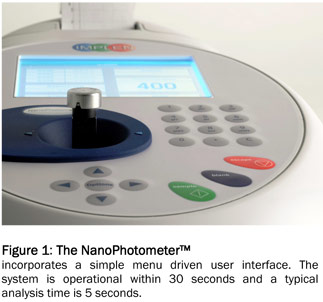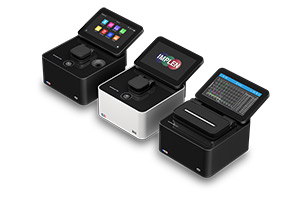The NanoPhotometer® Forensic Blood Analysis – New Approach to Determine Time since Deposition of Blood at Crime Scenes
NanoPhotometer® Application Notes
Malcom Lee, Dr. Andrea Huber
Implen GmbH, Munich, Germany
Abstract
So far, there is no generally accepted procedure available that enables forensic scientists to determine the age of blood stains at a crime scene. Present methods are either limited in their predictive power or their analytical sensitivity.
 In a recent study, by the National Center for Forensic Science at the University of Central Florida, a previously unidentified wavelength effect which shows a significant relationship to the lifetime of a blood stain has been discovered. The degree of this wavelength effect allows for more accurate determination of the time since the blood was deposited and it is now possible to differentiate between stains that were deposited minutes, hours, days and months ago. Using the NanoPhotometer® from Implen the scientists at the National Center for Forensic Science established that tiny bloodstains of only 1 μl could be used for this investigation. One of the benefits of the NanoPhotometer® is that it is portable and therefore may be taken to the crime scene to first of all confirm that the stain was blood and then to determine how long it had been there. The instrument is perfectly optimized for this forensic application as it may operate from a 12 V DC supply if required, has no moving parts for in-field reliability, does not require regular servicing or calibration and requires very little operator training plus of course it provides high performance on low sample volumes (Figure 1).
In a recent study, by the National Center for Forensic Science at the University of Central Florida, a previously unidentified wavelength effect which shows a significant relationship to the lifetime of a blood stain has been discovered. The degree of this wavelength effect allows for more accurate determination of the time since the blood was deposited and it is now possible to differentiate between stains that were deposited minutes, hours, days and months ago. Using the NanoPhotometer® from Implen the scientists at the National Center for Forensic Science established that tiny bloodstains of only 1 μl could be used for this investigation. One of the benefits of the NanoPhotometer® is that it is portable and therefore may be taken to the crime scene to first of all confirm that the stain was blood and then to determine how long it had been there. The instrument is perfectly optimized for this forensic application as it may operate from a 12 V DC supply if required, has no moving parts for in-field reliability, does not require regular servicing or calibration and requires very little operator training plus of course it provides high performance on low sample volumes (Figure 1).
Methodology and technical requirements
After the blood samples have been obtained they were deposited on cloth and stored for different times and at different temperatures to simulate normal environmental conditions. The blood was then extracted with Tris-HCl, pH 8.0, spun and then stored at – 20 °C until required. The principle on which this work is based is that, as the blood ages, chemical reactions changing the spectral profiles of the blood samples still occur.
 The spectral profiles of the representative blood samples were obtained with the NanoPhotometer® using 0.5 -3 μl of the extracted solution placed directly onto the LabelGuard™ analytical cell (Figure 2).
The spectral profiles of the representative blood samples were obtained with the NanoPhotometer® using 0.5 -3 μl of the extracted solution placed directly onto the LabelGuard™ analytical cell (Figure 2).
The reproducibility of this technical design is excellent due to the fixed pathlength mechanism and the fully enclosed sample area to prevent evaporation or contamination. As the sample is compressed, between the cell and the lid, surface tension effects due to solvents are overcome and will not affect the results. In addition to the blood analysis application the NanoPhotometer® is also an all-rounder for various spectrophotometrical applications in a modern laboratory. For example DNA/RNA specific applications are widely used in forensic laboratories when accurate quantification of concentration is required. Based on the available methods for single/multiple wavelength and concentration measurements, full spectrum scans, standard curve determinations as well as ratio calculations and even kinetics, the user may generate customized applications for their individual needs. Predefined methods and functions are available for nucleic acid analysis, determination of dye labeling efficiency, protein quantification and cell density measurements.
Results and conclusion
The researchers at the National Center for Forensic Science at the University of Central Florida have investigated many parameters of the haemoglobin spectrum and found a novel unique wavelength shift (hypsochromic shift of the Soret band of haemoglobin) that was directly proportional to the time of deposition. Graphing this Soret band wavelength shift as a function of stain age for bloodstains indicated a strong positive correlation so that it was possible to distinguish the deposition time of blood samples between months, days, hours and even minutes. When used in conjunction with the Implen NanoPhotometer®, it may be possible to perform this analysis at the actual crime scene, first to confirm the presence of a bloodstain (through a characteristic UVVIS spectral profile) and also to determine the time since deposition of that bloodstain using only microliter volumes of blood.
The full research document may be found at http://www.ncjrs.gov/pdffiles1/nij/grants/226811.pdf.
Acknowledgment
Implen GmbH acknowledges the cooperation of the National Center for Forensic Science at the University of Central Florida for their dedication and comprehensive research into this subject.
Contact
Implen GmbH
Am Schatzbogen 52
81829 Munich
Germany
Malcolm Lee
Dr. Andrea Huber
Email: [email protected]
Phone: +49-89-7263718 0
Implen Inc.
Suite 521-23
5655 Lindero Canyon Road
Westlake Village, CA 91362
USA
Dr. Thomas Sahiri
Email: [email protected]
Phone: +1-818-706 3500





